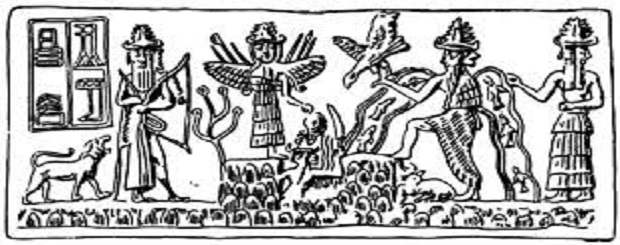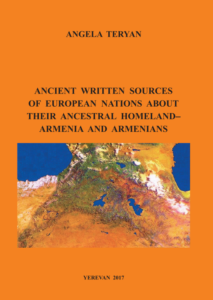
BOOK – HISTORY – ANCIENT CIVILIZATION CULTURE – ARMENIA.

ANGELA TERYAN
Preface
Armenia is one of the ancient countries of the world. Armenians (hay-armens), the natives of the Armenian Highlands, are one of the ancient nations of South-Western Asia, and Armenian is one of the ancient languages in the world.
According to studies in the Armenian Highlands and in surrounding territotories Armenian used to be a spoken language more than 9000 years ago. New studies have come to testify that these surrounding territories were also the ancestral Homeland of Arian tribes, the ancestors of Indo-Europeans.
From then on, these tribes started moving from their Homeland, the Armenian Highlands, and its surrounding territories, to countries where they live at present on territories between Europe and India. The ancient maps of the world, also testify that Armenians (hay-armens) are the ancient inhabitants of South Western Asia, and that Armenia is one of the ancient countries of the world.
The famous ancient image of the Universe and Mother Earth is a Sumerian map (middle of the III millennium B.C.) on a clay-tablet1 (see p. 122), on which mountains (the Armenian Highlands), Mesopotamia and the rivers Tigris and Euphrates, originating from the Armenian Highlands, are indicated.
Those territories, having been settled by hay-armens before the appearance of Semitic tribes (Akkadians and later Babylonians and Assyrians), were known to the Sumerian people in the middle of the III millennium B.C.2 It is
——————
1 The History of Ancient East, part 1, M., 1983
2 Asia Minor was populated by Thracians, Lydians, Phrygians, Pelasgians, Trojans,
Etruscans, etc. According to Robert Ellis, an English researcher, they were Armenian tribes
and spoke Armenian (dialects). (Robert Ellis: The Armenian Origin of the Etruscans, 1861:
http://www.hayagitaran.info). We should not forget that in the ‘‘Iliad’’ by Homer and ‘‘Trojan
War’’ (12th-9th cc. B.C.), Thracians, Phrygians, Lycians and other neighbouring tribes, joined
each other during imminent danger and helped the Trojan king Prian. According to the Armenian prominent historian Movses Khorenatsi (410-490 A.D.), Trojans were also helped by Armenian brave warriors lead by the epic hero Zarmayr Nahapet, who was wounded and later
died during the war, (M. Khorenatsi, History of the Armenians, Yerevan, 1981, p. 107). R.
Ellis writes that from Italy to Armenia, the fl ow of Armenian speakers was interrupted only
when Syrian or Assyrian people (semitic tribes) came up from the south and appeared between Armenia and Phrygia, hindering their close relationship. That territory was called Cappadocia, In the Eastern part of which Armenian was also spoken. Later the tribes (Armenian
also known that the former settlements of the Sumerians were the southern parts of the Armenian Highlands,3 from where, making little shifts, they appeared in Southern or Lower Mesopotamia.4
According to results of archaeological excavations, Sumerians were already in Lower Mesopotamia in the V–IV millennia B.C.5 There are notes about “high mounts”, “gods”, “immortals”, “holy laws” and “sacred ceremonies” of Aratta country6 in the Sumerian heroic epic “Gilgamesh” (“Gilgamesh and the Land of Immortals”, “Enmerkar and the Lord of Aratta”, “Lugalbanda and Mount Hurum” and other heroic epics). Arrata is one of the ancient names of Armenia. It must be noted that the migration of Sumerians to the south is considered to be the first known migration from the Armenian Highlands. Armenia is represented on a Babylonian star-like map (6th c. B.C.), on the map of Heca

living on the Western territories from the Armenian Highlands, started to develop separately, further spreading to the West; to Greece, the Apennine Peninsula, the Balkans and
Europe.
There are also other sources about Thrace and Thracians. Thus, Hovhannes Draskhanakerttsi (9th c.) considered that Tiras, who was the grandfather of Armenians’ forefather Hayk, was also the forefather of Thracians (Hovhannes Draskhanakerttsi, History of Armenia, Tifl is, 1912, p. 11), while According to Strabo, Thracians lived to the North of Armenia, among the Guran and the Med tribes, on the territory between Lake Urmia and the Caucasus Mountains (Strabo, XI, 44).
These ancient sources state that the forefather of Thracians was one of the Armenian ancestors Tiras, and the Land Thracia was in the Armenian Highlands. Today Thracia is located in the eastern part of the Balkan Peninsula. 3 G. Childe, ‘‘New Light on the Most Ancient East’’, M., 1956; I. Kaneva, “Enmerkarand the Lord of Aratta”, Journal of Ancient History, 1964, History of Ancient East, part I, 1983, p. 92. 4 Studies allow us to say that many ancient cultures (Neolithic, Kur-Araks or Shengavit,Bronze Age, etc.) were created by the people of Armenoid type of the Europoid race.
Uncovered ancient images and fi gures of gods and kings represent the Armenoid anthropological
type. The images of Egyptian pharaohs and Akkadian kings are exceptions as, according to
uncovered ancient written sources, the Armenoid type was treated inimically by them. The
reason is supposed to be the following: The study of the history of mankind shows that since
the Neolithic period (10th c. B.C.) the Armenoid type has always been in the center of important events of the formation and evolution of people’s tribes.
The people of the Armenoid type took active part in those events. Its permanent and important role in all the events was most probably the reason of hostile attitude towards the Armenoid type. 5 J. Mellaart, “Earliest Civilizations of the Near East”, M., 1982, L. Woolley, “A forgotten kingdom”, M., 1986. 6 Kramer S. N., The Sumerians, Chicago, 1963; I. Kaneva, Journal of Ancient History,
1964, 4, p. 208.
angelateryan.files.wordpress.com/2017/07/anjela-teryan_angleren-compressed.pdf
